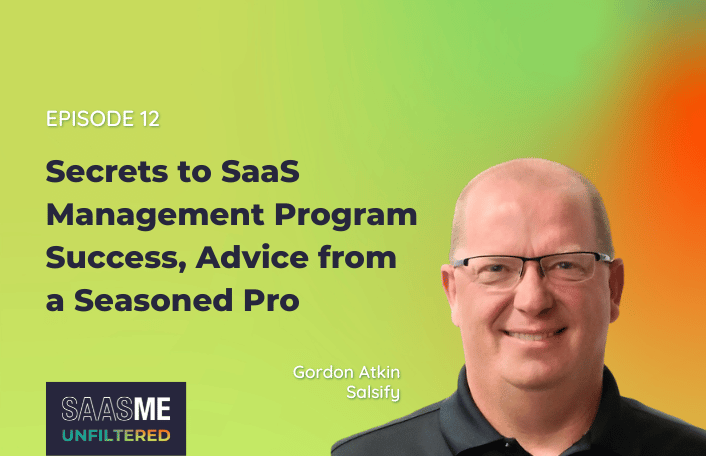11/16/2022
Table of Contents
Gordon Atkin at Salsify believes that having a SaaS management program isn’t a nice-to-have. It’s a must have. In this episode of SaaSMe Unfiltered, Gordon shares his secrets for an effective and successful SaaS management practice and explains why traditional asset management solutions just won’t do.
Listen to the full episode on Spotify and Apple Podcasts.
Episode Summary
In the world of business, one thing is certain: SaaS is growing. Zylo research found that the average company has 323 SaaS apps – with 8 new ones entering the ecosystem every month.
SaaS is essential to the success of just about any organization. But those costs add up. At the vast majority of companies, SaaS is the second largest operating expense – only behind people.
As SaaS continues to grow at organizations of all sizes, Gordon Atkin, VP of Technology and Business Platform at Salsify, believes a SaaS management practice is imperative.
“You look at tooling from a must-have, need-to-have, nice-to-have perspective, right? To me, SaaS management is a must-have. I’ve now been at three different organizations since I was first introduced to Zylo, and usually, one of my top initiatives when I start within the first 90 days is, what are we doing around SaaS management? So, it is one of those things that I really think is a must have.”
But traditional asset management platforms aren’t built for the challenges and opportunities of SaaS. Instead, a dedicated SaaS management platform is key.
“[SaaS] is the number two spend in especially SaaS companies. For more traditional legacy or on-premise companies, it’s going to be a cost that continues to creep up, and traditional software asset-tracking solutions aren’t going to help you manage that.”
Guest Spotlight
Name: Gordon Atkin
What he does: VP of Technology and Business Platform at Salsify
Connected with Gordon online: LinkedIn
Episode Highlights
For a CIO, Taking a Company Public Boils Down to Three Different Buckets
“One of the big buckets is process and control, making sure that we’ve got the right processes in place and that we’re giving our auditors comfort around our change control practices. Access and change management is another big bucket, making sure that, again, back to segregation of duties, that there is a very clear line of responsibility between who does what and how they do it. Then I think the third bucket is going to be around how are you going to manage the growth of your environment and making sure that you’ve got a strategy that is aligned to the executive strategy. Auditors do care about is their alignment from the top to the bottom around an IT strategy, right, and how you’re going to grow that strategy over time, and so they want to make sure that you’ve got a strategy that’s connected to at the highest level, and so making sure that you’ve got steering committees, that you’ve got things that really connect your vision to the overall company vision is what I would say are some of the key lessons that I learned going through IPOs.”
The Right Playbook is Key to Being an Effective, Fast-Moving CIO
“I really rely on Gartner’s playbook, to be honest. And I’ve relied on it ever since I was introduced to Gartner’s playbook back when I was at Instructure in the mid- 2010s. One of the key parts of Gartner’s model is looking at and evaluating where you are, where does the company want you to be from an operating model perspective. There are five levels that you can be from an operating model perspective. You can be a ‘let’s keep the lights on’ type of business. Let’s protect the company, let’s make sure that employees are getting their laptops, that they’re secure, and that we’re just running the business effectively. We’re not doing major changes, or dramatic changes. That requires a different level of staffing and strategy than if you want to grow, enhance, or transform the business.”
CIO is one of the Hardest Jobs at a Company
“I think successful CIOs have a good skill around understanding the completeness of the business and developing relationships within the business to help understand where value needs to be driven from an IT perspective. That’s hard for me to kind of say in one word what I think the top skill is, but I do think that developing relationships and really understanding the breadth of the business in detail, right, it’s not just about understanding that there’s marketing and there’s sales and there’s manufacturing and all these things, right? In my opinion, being the CIO is the hardest job at a company because you have to understand in depth everything across the business in order to support the business properly, and I don’t know of any other organization that supports the business as deeply as an IT organization does.”
Establishing a Complete Inventory of Your SaaS is Foundational
“You’ve got to get your arms around the complete [SaaS] inventory I think is the first step you’ve got to have. And so you’ve got to understand the complete inventory of what applications do you have, whether that’s through your AP spend, through your expense spend, or through the credit card spend.”
When it Comes to SaaS Management, Spreadsheets Won’t Cut It
“I remember when I was at Instructure, we were going through an exercise, and it was like, ‘How many tools do we have?’ This was back in 2014 before SaaS management really became a thing, and we couldn’t answer that question very effectively. So we started putting together a spreadsheet. We put a spreadsheet together, we started listing all the applications that we knew of, we started looking at where we were spending money, and we came up with I think like 150 applications, or something like that. Then shortly into that exercise when I was introduced to Zylo, Zylo did their magic, and we found out that I think we had, I don’t know, 350 applications. I mean, the number was just astonishing through that exercise to go, ‘Wow, we really don’t know what we have.’”
Benchmarking is Key to Portfolio Optimization
“I would say benchmarking is the key component there because you want to know if you’re spending a million dollars on Salesforce, is that high, medium, or low compared to others that are of similar size or have a similar footprint? I would say benchmarking is a really key component of understanding and managing the overall SaaS footprint. When it comes to really being SaaS-driven, you want that built into the SaaS management platform that you’re using.”
There are Two Magical Moments in SaaS Management
“It’s intake and renewal. The reason why I call it a program is because of how many people SaaS touches, especially upon intake and renewal. When you think about the intake process, you have procurement, you have finance, you have information security, you have IT, you have all these different parts of the organization, you have legal, you have all these people who are looking at, ‘We’re doing new business with a vendor. How do we manage this effectively?’ Most companies will call it vendor intake, but I think that vendor intake is part of the overall SaaS management program, right, is a piece of the puzzle. When you say, ‘We run a SaaS management program,’ and vendor intake is part of that, renewals is part of that, right? When a renewal comes, fewer players are involved. You still have IT, you still have finance, and you still have procurement. Legal is less involved because we’ve typically agreed to the terms and conditions with the organization, but you still have to manage that collectively.”
Offboarding and Deprecating Apps is Important – But Often Overlooked
“I do think that that is something, even in my own experience that is something that is forgotten. We don’t offboard vendors in the right way, right? You have to think about privacy, you have to get rid of data, you have to make sure that you have evidence that your information has been cleansed from the SaaS provider, so to speak. I would say that that piece is less procurement and more IT and more information and security in terms of running that program effectively.”
SaaS Management is a Must-Have
“I would say you look at tooling from a must-have, need-to-have, nice-to-have perspective, right? To me, SaaS management is a must-have. The reason why I believe that, again, going back to leaning on the metric, right, it’s the number two spend in especially SaaS companies. For more traditional legacy or on-premise companies, it’s going to be a cost that continues to creep up, and traditional software asset tracking solutions aren’t going to help you manage that. So to me, it falls into the camp of must-have. As Cory alluded to, I’ve now been at three different organizations since I was first introduced to Zylo, and usually, one of my top initiatives when I start within the first 90 days is, what are we doing around SaaS management? So, it is one of those things that I really think is a must have.”
Top Quotes
4:04 – “I can’t imagine why you wouldn’t want to have a program around managing SaaS spend.”
11:04 – “The person who cares most about it in the organization is typically the IT leader, and the person who cares second most about it is the CFO, no question, hands down.”
12:58 – “You’ve got to get your arms around the complete [SaaS] inventory.”
21:32 – “I would say you look at tooling from a must-have, need-to-have, nice-to-have perspective, right? To me, SaaS management is a must- have.”
21:47 – [SaaS] is the number two spend in especially SaaS companies. For more traditional legacy or on-premise companies, it’s going to be a cost that continues to creep up, and traditional software asset-tracking solutions aren’t going to help you manage that
Recommended Resources
- America’s Funniest Home Videos (Jump to 1:44 for Gordon’s moment of fame)
- TheGrint
Listen and subscribe to SaaSMe Unfiltered wherever you listen to podcasts.
ABOUT THE AUTHOR

Cory Wheeler
As Zylo’s Chief Customer Officer, Cory is responsible for helping our customers drive ROI and SaaS Management success with Zylo. He helps companies of all sizes effectively discover, optimize, and govern their SaaS through Zylo’s platform and services. Prior to founding Zylo, Cory spent 15 years in finance and procurement, managing categories and sourcing teams at Arthur Andersen, BearingPoint, and both Takeda and Astellas Pharmaceuticals. He built the procurement organization at ExactTarget, and managed the integration with the Salesforce Marketing Cloud procurement organization in 2015. He and his family reside in Indianapolis, IN, where they can be found cheering for the Purdue Boilermakers and Chicago Cubs.

